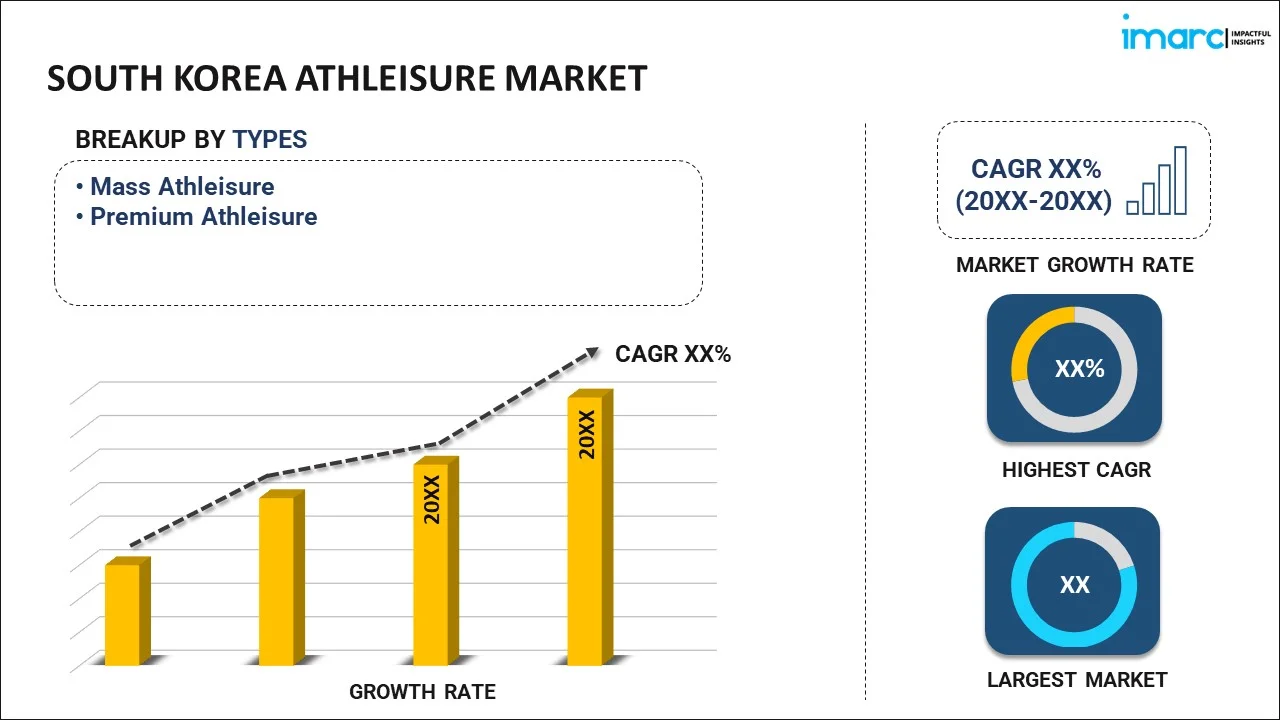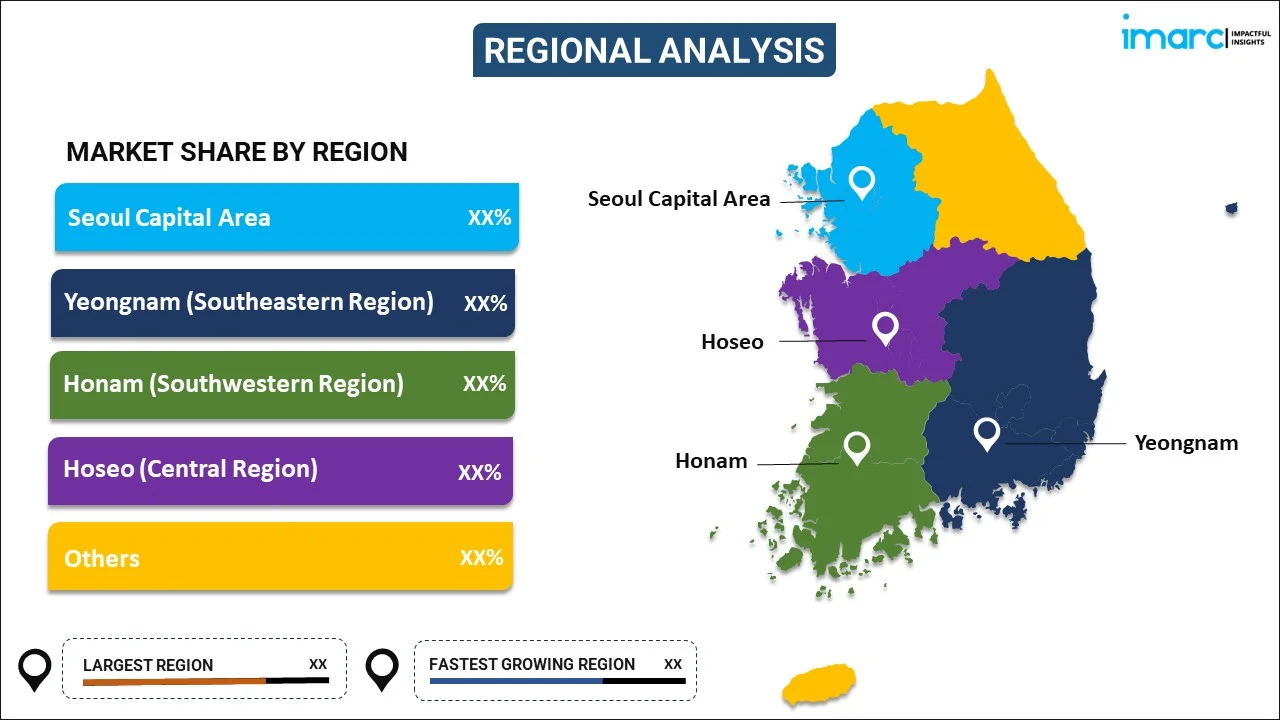
South Korea Athleisure Market Report by Type (Mass Athleisure, Premium Athleisure), Product (Yoga Apparels (Tops, Pants, Unitards, Capris, Others) Hoodies, Shirts, Leggings, Shorts, and Others), Distribution Channel (Online, Offline), End User (Men, Women, Children), and Region 2024-2032
Market Overview:
South Korea athleisure market size is projected to exhibit a growth rate (CAGR) of 6.26% during 2024-2032. The increasing health and wellness trend among South Koreans, rising influence of K-pop and Korean celebrities, recent technological advancements in textile manufacturing, and growing acceptance of casual dress codes in the workplace represent some of the key factors driving the market.
|
Report Attribute
|
Key Statistics
|
|---|---|
|
Base Year
|
2023 |
|
Forecast Years
|
2024-2032 |
|
Historical Years
|
2018-2023
|
| Market Growth Rate (2024-2032) | 6.26% |
Athleisure refers to a fashion trend that blends athletic wear with leisure attire, designed for both fitness and everyday wear. It incorporates clothing that is both functional and stylish, enabling a seamless transition from workouts to social settings. Athleisure is available in various types, such as leggings, joggers, sports bras, hoodies, tank tops, and sneakers. It is comprised of several components, including moisture-wicking fabrics, stretchability, breathability, and durability. Athleisure possesses different features which contribute to comfort, flexibility, and aesthetic appeal. It is widely used for various activities, including yoga, running, gym workouts, and casual social gatherings. Athleisure offers numerous benefits, such as versatility, comfort, style, functionality, and ease of care. In addition, it supports an active lifestyle, promotes body positivity, encourages self-expression, and aligns with sustainable fashion trends.
South Korea Athleisure Market Trends:
The increasing health and wellness trend among South Koreans, which is prompting more individuals to engage in fitness activities, is boosting the market growth. Additionally, the rising influence of K-pop culture and Korean celebrities, known for their fashion-forward and health-conscious lifestyles, is propelling the market growth. Besides this, recent technological advancements in textile manufacturing, leading to the development of high-quality, durable, and comfortable fabrics, making athleisure wear more appealing, is catalyzing the market growth. Furthermore, the rise of social media marketing, which is playing a pivotal role in promoting athleisure as a lifestyle, leading to increased consumer engagement and awareness, is contributing to the market growth. In addition, the growing acceptance of casual dress codes in the workplace, which is endorsing the adoption of athleisure wear, is supporting the market growth. Apart from this, the surge in e-commerce and online shopping platforms, making athleisure more accessible to a broader audience, is favoring the market growth. Moreover, the escalating collaborations between fashion brands and athletes, resulting in the creation of innovative and trendy athleisure collections, are positively influencing the market growth. Along with this, the expanding urban population, coupled with the fast-paced lifestyle of city dwellers, which necessitates versatile clothing options, is fueling the market growth. Additionally, the increasing participation of women in sports and fitness activities, which contributes to the growing demand for women's athleisure wear, is driving the market growth. Furthermore, the ongoing pursuit of sustainable and eco-friendly fashion options, leading to the development of athleisure wear using recycled and organic materials, is strengthening the market growth. Besides this, the rising middle class with increased disposable income, willing to spend on premium athleisure brands, is acting as another growth-inducing factor. In addition to this, the imposition of different government policies encouraging sports and recreational activities is bolstering the market growth.
South Korea Athleisure Market Segmentation:
IMARC Group provides an analysis of the key trends in each segment of the market, along with forecasts at the country level for 2024-2032. Our report has categorized the market based on type, product, distribution channel, and end user.
Type Insights:

- Mass Athleisure
- Premium Athleisure
The report has provided a detailed breakup and analysis of the market based on the type. This includes mass athleisure and premium athleisure.
Product Insights:
- Yoga Apparels (Tops, Pants, Unitards, Capris, Others) Hoodies
- Shirts
- Leggings
- Shorts
- Others
A detailed breakup and analysis of the market based on the product have also been provided in the report. This includes yoga apparels (tops, pants, unitards, capris, others) hoodies, shirts, leggings, shorts, and others.
Distribution Channel Insights:
- Online
- Offline
The report has provided a detailed breakup and analysis of the market based on the distribution channel. This includes online and offline.
End User Insights:
- Men
- Women
- Children
A detailed breakup and analysis of the market based on the end user have also been provided in the report. This includes men, women, and children.
Regional Insights:

- Seoul Capital Area
- Yeongnam (Southeastern Region)
- Honam (Southwestern Region)
- Hoseo (Central Region)
- Others
The report has also provided a comprehensive analysis of all the major regional markets, which include Seoul Capital Area, Yeongnam (Southeastern Region), Honam (Southwestern Region), Hoseo (Central Region), and others.
Competitive Landscape:
The market research report has also provided a comprehensive analysis of the competitive landscape. Competitive analysis such as market structure, key player positioning, top winning strategies, competitive dashboard, and company evaluation quadrant has been covered in the report. Also, detailed profiles of all major companies have been provided.
South Korea Athleisure Market Report Coverage:
| Report Features | Details |
|---|---|
| Base Year of the Analysis | 2023 |
| Historical Period | 2018-2023 |
| Forecast Period | 2024-2032 |
| Units | US$ Million |
| Scope of the Report | Exploration of Historical Trends and Market Outlook, Industry Catalysts and Challenges, Segment-Wise Historical and Future Market Assessment:
|
| Types Covered | Mass Athleisure, Premium Athleisure |
| Products Covered | Yoga Apparels (Tops, Pants, Unitards, Capris, Others) Hoodies, Shirts, Leggings, Shorts, Others |
| Distribution Channels Covered | Online, Offline |
| End Users Covered | Men, Women, Children |
| Regions Covered | Seoul Capital Area, Yeongnam (Southeastern Region), Honam (Southwestern Region), Hoseo (Central Region), Others |
| Customization Scope | 10% Free Customization |
| Report Price and Purchase Option | Single User License: US$ 3699 Five User License: US$ 4699 Corporate License: US$ 5699 |
| Post-Sale Analyst Support | 10-12 Weeks |
| Delivery Format | PDF and Excel through Email (We can also provide the editable version of the report in PPT/Word format on special request) |
Key Questions Answered in This Report:
- How has the South Korea athleisure market performed so far and how will it perform in the coming years?
- What has been the impact of COVID-19 on the South Korea athleisure market?
- What is the breakup of the South Korea athleisure market on the basis of type?
- What is the breakup of the South Korea athleisure market on the basis of product?
- What is the breakup of the South Korea athleisure market on the basis of distribution channel?
- What is the breakup of the South Korea athleisure market on the basis of end user?
- What are the various stages in the value chain of the South Korea athleisure market?
- What are the key driving factors and challenges in the South Korea athleisure?
- What is the structure of the South Korea athleisure market and who are the key players?
- What is the degree of competition in the South Korea athleisure market?
Key Benefits for Stakeholders:
- IMARC’s industry report offers a comprehensive quantitative analysis of various market segments, historical and current market trends, market forecasts, and dynamics of the South Korea athleisure market from 2018-2032.
- The research report provides the latest information on the market drivers, challenges, and opportunities in the South Korea athleisure market.
- Porter's five forces analysis assist stakeholders in assessing the impact of new entrants, competitive rivalry, supplier power, buyer power, and the threat of substitution. It helps stakeholders to analyze the level of competition within the South Korea athleisure industry and its attractiveness.
- Competitive landscape allows stakeholders to understand their competitive environment and provides an insight into the current positions of key players in the market.
Need more help?
- Speak to our experienced analysts for insights on the current market scenarios.
- Include additional segments and countries to customize the report as per your requirement.
- Gain an unparalleled competitive advantage in your domain by understanding how to utilize the report and positively impacting your operations and revenue.
- For further assistance, please connect with our analysts.
 Inquire Before Buying
Inquire Before Buying
 Speak to an Analyst
Speak to an Analyst
 Request Brochure
Request Brochure
 Request Customization
Request Customization




.webp)




.webp)












